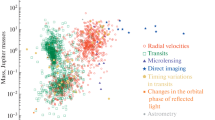Abstract
We analyze the mass distributions of exoplanets of three groups: transit planets discovered by the Kepler telescope, those found in ground-based observational programs and with the CoRoT satellite, and planets discovered in the vicinity of red dwarfs (M class) with the radial-velocity method. The dependence of the mass distributions of the Kepler transit planets on the spectral class of the host stars (F, G, and K classes) are considered. Taking into account the most significant factors of observational selection, which are different for each of the groups of planets, it has been shown that the mass distributions of exoplanets can be described by a universal power law with the index close to −2: dN/dm ∝ m−2. For the planets orbiting the stars of different spectral classes (F, G, K, and M), no statistically significant difference has been found.













Similar content being viewed by others
REFERENCES
Agekyan, T.A., Zvezdy. Galaktiki. Metagalaktiki (Stars, Galaxies, and Metagalaxy), Moscow: Nauka, 1981.
Ananyeva, V.I., Tavrov, A.V., Venkstern, A.A., Churbanov, D.V., Shashkova, I.A., Korablev, O.I., and Bertaux, J.L., The distribution of giant exoplanets over true and projective masses: accounting for observational selection, Sol. Syst. Res., 2019, vol. 53, no. 2, pp. 124–137.
Brewer, J.M., Wang, S., Fischer, D.A., and Foreman-Mackey, D., Compact multi-planet systems are more common around metal poor hosts, 2018. https://arxiv.org/pdf/1810.10009.pdf.
Butler, R.P., Wright, J.T., Marcy, G.W., Fischer, D.A., Vogt, S.S., Tinney, C.G., Jones, H.R.A., Carter, B.D., Johnson, J.A., McCarthy, C., and Penny, A.J., Catalog of nearby exoplanets, 2006. https://arxiv.org/pdf/astro-ph/0607493.pdf.
Christiansen, J.L., Clarke, B.D., Burke, C.J., Seader, Sh., Jenkins, J.M., Twicken, J.D., Smith, J.C., Batalha, N.M., Haas, M.R., Thompson, S.E., Campbell, J.R., Sabale, A., and Uddin, A.K., Measuring transit signal recovery in the Kepler pipeline II: Detection efficiency as calculated in one year of data, Astrophys. J., 2015, vol. 810, no. 2, art. ID 95. https://doi.org/10.1088/0004-637X/810/2/95
Christiansen, J.L, Clarke, B.D., Burke, C.J., Jenkins, J.M., Bryson, S.T., Coughlin, J.L., Mullally, F., Thompson, S.E., Twicken, J.D., Batalha, N.M., Haas, M.R., Catanzarite, J., Campbell, J.R., Uddin, A.K., Zamudio, K., et al., Measuring transit signal recovery in the Kepler pipeline. III. Completeness of the Q1–Q17 DR24 Planet Candidate Catalog with important caveats for occurrence rate calculations, Astrophys. J., 2016, vol. 828, p. 99. https://doi.org/10.3847/0004-637X/828/2/99
Cumming, A., Butler, R.P., Marcy, G.W., Vogt, S.S., Wright, J.T., and Fischer, D.A., The Keck planet search: detectability and the minimum mass and orbital period distribution of extrasolar planets, Proc. Astron. Soc. Pac., 2008, vol. 120, no. 867, pp. 531–554. https://doi.org/10.1086/588487
Ho, S. and Turner, E.L., The Posterior distribution of sin(i) values for exoplanets with Mt sin(i) determined from radial velocity data, Astrophys. J., 2011, vol. 739. https://doi.org/10.1088/0004-637X/739/1/26
Howard, A.W., Marcy, G.W., Johnson, J.A., Fischer, D.A., Wright, J.T., Isaacson, H., Valenti, J.A., Anderson, J., Lin, D.N.C., and Ida, S., The occurrence and mass distribution of close-in super-Earths, Neptunes, and Jupiters, Science, 2010, vol. 330, no. 6004, pp. 653–655. https://doi.org/10.1126/science.1194854
Ivanova, A.E., Ananyeva, V.I., Venkstern, A.A., Shashkova, I.A., Yudaev, A.V., Tavrov, A.V., Korablev, O.I., and Bertaux, J.-L., The mass distribution of transiting exoplanets corrected for observational selection effects, Astron. Lett., 2019, vol. 45, no. 9, pp. 687–694. https://doi.org/10.1134/S1063773719100049
Jorissen, A., Mayor, M., and Undry, S., The distribution of exoplanet masses, Astron. Astrophys., 2001, vol. 379, pp. 992–998. https://en.wikipedia.org/wiki/Kernel_density_estimation.https://doi.org/10.1051/0004-6361:20011373
Marcy, G., Butler, R.P., Fischer, D., Vogt, S., Wright, J.T., Tinney, C.G., and Jones, H.R.A., Observed properties of exoplanets: masses, orbits, and metallicities, Prog. Theor. Phys. Suppl., 2005, vol. 158, pp. 24–42. https://doi.org/10.1143/PTPS.158.24
NASA exoplanet archive, 2019. https://exoplanetarchive.ipac.caltech.edu/.
Perryman, M., The Exoplanet Handbook, Cambridge: Cambridge Univ. Press, 2011.
Petigura, E.A., Howard, A.W., and Marcy, G.W., Prevalence of Earth-size planets orbiting Sun-like stars, Proc. Natl. Acad. Sci. U.S.A., 2013, vol. 110, no. 48, pp. 19273–19278. https://doi.org/10.1073/pnas.1319909110
Rönz, B. and Förster, E., Regressions- und Korrelationsanalyse: Grundlagen—Methoden—Beispiele, Berlin: Springer-Verlag, 1992.
Sturges, H., The choice of a class-interval, J. Am. Stat. Assoc., 1926, vol. 21, pp. 65–66. https://vlgr.ranepa.ru/pp/hmp/bks100tv1314/lect_TV07.pdf. Accessed April 25, 2019.
Tenenbaum, P., Christiansen, J.L., Jenkins, J.M., Rowe, J.F., Seader, S., Caldwell, D.A., Clarke, B.D., Li, J., Quintana, E.V., Smith, J.C., Stumpe, M.C., Thompson, S.E., Twicken, J.D., and van Cleve, J., Detection of potential transit signals in the first three quarters of Kepler mission data, Astrophys. J. Suppl., 2012, vol. 199, p. 24. https://doi.org/10.1088/0067-0049/199/1/24
Twicken, J.D., Jenkins, J.M., Seader, S., Tenenbaum, P., Smith, J.C., Brownston, L.S., Burke, C.J., Catanzarite, J.H., Clarke, B.D., Cote, M.T., Girouard, F.R., Klaus, T.C., Li, J., McCauliff, S.D., Morris, R.L., et al., Detection of potential transit signals in 17 quarters of Kepler data: results of the final Kepler mission transiting planet search (DR25), Astron. J., 2016, vol. 152, p. 158. https://doi.org/10.3847/0004-6256/152/6/158
Tuomi, M., Jones, H.R.A., Butler, R.P., Arriagada, P., Vogt, S.S., Burt, J., Laughlin, G., Holden, B., Shectman, S.A., Crane, J.D., Thompson, I., Keiser, S., Jenkins, J.S., Berdiñas, Z., Diaz, M., et al., Frequency of planets orbiting M dwarfs in the Solar neighborhood, 2019. https://arxiv.org/pdf/1906.04644.pdf.
Udry, S., Fischer, D., and Queloz, D., A decade of radial-velocity discoveries of exoplanets. 2005. https://www.lpi.usra.edu/books/PPV/8058.pdf.
Winn, J.N., Exoplanet transits and occultations, in Exoplanets, Seager, S., Ed., Tucson: Univ. Arizona Press, 2014.
Funding
The study was supported by the Ministry of Education and Science of the Russian Federation (grant no. 14.W03.31.0017) and, in part of the last section, by the Russian Science Foundation ( grant no. 18-19-00452).
Author information
Authors and Affiliations
Corresponding author
Additional information
Translated by E. Petrova
Rights and permissions
About this article
Cite this article
Ananyeva, V.I., Ivanova, A.E., Venkstern, A.A. et al. The Dependence of the Mass Distribution of Exoplanets on the Spectral Class of Host Stars. Sol Syst Res 54, 175–186 (2020). https://doi.org/10.1134/S0038094620030016
Received:
Revised:
Accepted:
Published:
Issue Date:
DOI: https://doi.org/10.1134/S0038094620030016



